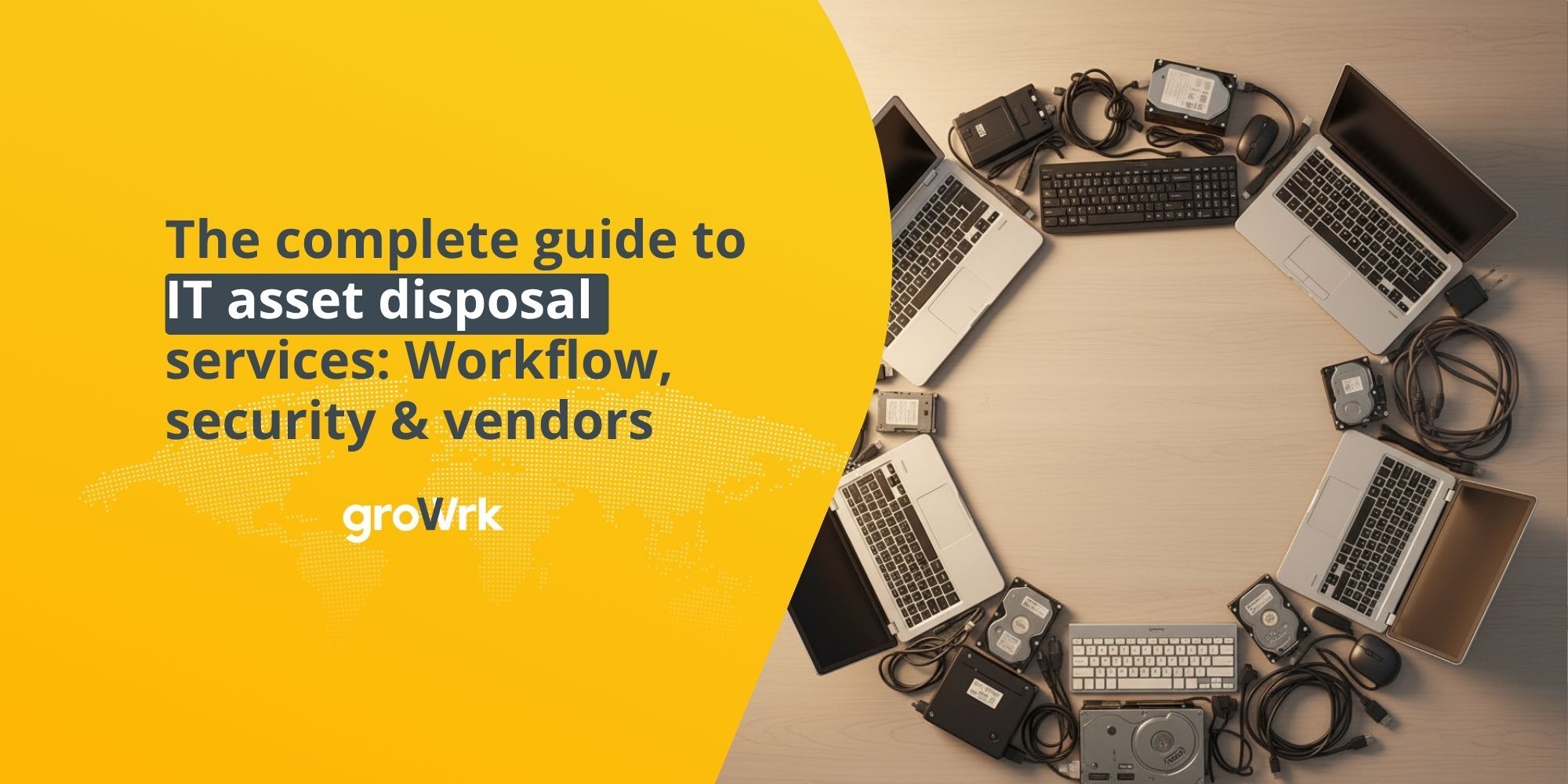Old IT equipment disposal for distributed teams
 Zachary Trudeau
Zachary Trudeau
Have you ever wondered what happens to old IT equipment when it is no longer useful? Over 50 million metric tons of e-waste are produced yearly. Managing this waste is crucial to reduce environmental impact, optimize resources, and protect data.
Imagine valuable materials like gold, silver, copper, and palladium ending up in a digital cemetery because there was no proper IT asset disposition (ITAD) plan. Toxic materials from the various components wreaking havoc on the ecosystem are just one factor; the procurement and labor costs to obtain new resources are another.
Moreover, what if electronic equipment is disposed of illegally in violation of compliance standards, and your company gets penalized with fines and sanctions? Perhaps sensitive information ended up with hackers because of improper computer disposal. Now, imagine having to traverse these challenges across different countries.
As the drive towards digital transformation accelerates, devices quickly become obsolete or require increasing upgrades and updates; this can easily feel overwhelming for IT managers in distributed teams. Let's look at the available solutions for IT asset disposition (ITAD) that will help your company align with corporate social responsibility goals and uncover opportunities to recover costs.
What to do with old IT equipment?

When it's time to refresh your organization's technology, there are different strategies that can turn old IT equipment from a disposal challenge into an opportunity. These methods address environmental concerns and offer ways to save money for your business and comply with corporate social responsibility. Your company can explore recycling, selling, donating, or repurposing old computers to manage tech transitions responsibly.
Recycling programs
E-waste recycling programs are a primary method of environmental stewardship. They allow companies to safely dispose of outdated IT equipment in an eco-friendly manner. The recycling route underscores a commitment to minimizing environmental impact and adhering to sustainable practices.
When working in a distributed teams, partnering with an IT asset disposition solution is crucial for responsible electronic waste management. This way, it will be easier to find local waste management programs in the cities where your team is present.
Sell old equipment
Selling old computers that are still functional is a strategic avenue for organizations looking to finance technology updates. This approach not only supports the circular economy by extending the lifecycle of devices but also offers a financial boon that can offset the costs of new hardware acquisitions. It embodies a win-win scenario, ensuring technology continues to serve purposeful roles beyond its original context.
For global teams, this can look like selling the devices at a discount to employees or through online auctions to dispose of old, yet functional, equipment. Having dedicated laptop retrieval services can also help to recoup costs and extending the lifecycle of IT assets.
Donate older devices
Donating represents just a few options as a powerful means to bolster corporate social responsibility. By channeling old computers to an educational institution or non-profit organization, companies can make a tangible difference in communities, enhancing educational opportunities and bridging digital divides. This path enriches the company’s social impact and breathes new life into equipment, serving noble ends.
This option requires special effort for distributed teams, as it involves reaching out to local schools, a nonprofit organization, or a community center to inquire about their technology needs and coordinating a delivery.
Repurpose old computer equipment
Repurposing within the company harnesses creative and cost-effective strategies to extend the utility of IT assets. For distributed teams, this could involve converting old laptops into dedicated project management stations, transforming desktops into testing environments, or repurposing servers for data backups or development servers. Repurposing maximizes the value derived from initial investments and shows a commitment to eco-conscious resource management.
Challenges of IT equipment disposal for distributed teams

Disposing of old IT equipment in a distributed setting involves more than calling your local e-waste management center. Coordinating collections, ensuring data security, and environmentally responsible disposal are complex on their own but more so at a global scale. Having decentralized operations requires clear protocols to manage the destruction of sensible data and responsible dispose of old equipment. Let's look at the main roadblocks that distributed teams might face during the equipment disposal process.
Coordinating recycling programs across countries
Coordinating disposal efforts across different regions and countries requires a deep understanding of the various logistics networks involved and the ability to navigate them efficiently. This means factoring in things like local regulations, waste management practices, and environmental impact assessments. Additionally, there are often security and privacy concerns to address, such as ensuring that all the information is securely wiped from any devices before they are disposed of.
Country-specific regulations
The disposal process is magnified by the patchwork of country-specific regulations governing e-waste. For instance, the United States features a variety of state-specific laws, such as California's Electronic Waste Recycling Act, which imposes specific electronic recycling requirements. Meanwhile, the European Union's Waste Electrical and Electronic Equipment (WEEE) directive sets forth comprehensive rules on e-waste, mandating collection, recycling, and recovery targets for all types of electrical goods.
Finding certified e-waste programs
Companies must seek out and partner with certified e-waste recyclers or ITAD providers that ensure compliance with local laws and align with global sustainability goals. This process involves rigorous research to identify partners with the necessary certifications and capabilities to handle e-waste in an environmentally responsible manner across different regions.
What is the IT equipment disposal process?
If your company plans to dispose of IT equipment, you should follow a process that prioritizes data security and environmental responsibility. Here are the basic steps to consider for a safe disposal of electronic waste.

Data wiping
Data deletion is a critical process that helps protect sensitive information from data breaches and maintain privacy. There are various techniques available for wiping data completely, including wiping software or a factory reset.
Dismantling devices
Following data removal, the physical dismantling of the device takes place. This step segregates all the data and devices into their constituent materials—metals, plastics, and computer parts. This step ensures that valuable materials can be recycled and that toxic components get discarded safely in preparation for recycling.
Creating new products
The materials are then processed and transformed, potentially becoming raw materials for new products. This recycling and repurposing stage is key to the circular economy, which can significantly reduce waste and environmental impact while conserving resources.
Throughout this process, adherence to proper methods and regulations is paramount, ensuring that each step, from data erasure to recycling, aligns with best practices and legal requirements. The ultimate goal is to recycle and to extend the lifecycle of the device’s materials, supporting sustainability and reducing the global footprint of electronic waste.
How does old IT equipment get recycled?
Recycling old IT equipment is a multifaceted process that ensures the environmentally responsible disposal of obsolete technology. Because there are many different materials inside a computer, there are many ways to recycle them. However, most recycling processes follow a similar pattern, including these common steps:
Collecting and transporting old equipment
The journey begins with the collection and secure transportation of old devices to specialized facilities, where they are carefully handled to protect any sensitive data or hazardous substances they may contain. This stage is critical, laying the groundwork for recycling by ensuring the equipment is safely transported without compromising data security or environmental integrity.
Shredding and sorting devices
Once at the recycling facility, the equipment undergoes shredding, a process that reduces devices to smaller fragments, making it easier to separate various materials such as metals, plastics, and glass. This step is crucial for efficient material recovery, as it allows for the more precise sorting of components.
Extracting dust from e-waste
Following shredding, sophisticated systems are employed to extract dust and other fine particles generated during the process, ensuring a clean and safe working environment for the subsequent stages of material separation.
Separating materials
The sorting and separation phase involves several advanced techniques to isolate different materials. Magnetic separation is used to extract ferrous metals, leveraging their magnetic properties to cleanly and efficiently segregate them from the rest of the materials. In contrast, water separation techniques are employed for glass components, taking advantage of density differences to separate glass from lighter materials. This stage is essential for the effective recovery of recyclable and hazardous materials each requiring specific handling and processing methods to ensure their suitability for reuse.
Preparing recycled materials for sale
Following the thorough separation and purification of materials, the recycled components are prepared for sale to manufacturers, who can then use these materials to produce new products. This stage marks the completion of the electronics recycling process, transforming obsolete IT equipment into valuable resources.
The entire process contributes to the reduction of e-waste and promotes the conservation of natural resources by providing manufacturers with recycled materials, thereby reducing the demand for new resources. This circular approach to IT equipment disposal underscores the importance of recycling in achieving environmental sustainability and the role of technology in fostering a more sustainable future.
How to ensure a safe disposal of your IT equipment with GroWrk
Managing the lifecycle of IT equipment presents a complex challenge, encompassing not only the procurement and deployment of storage devices but also their secure and environmentally friendly disposal.
GroWrk offers an end-to-end solution that ensures your IT equipment is managed responsibly throughout its entire lifecycle. Our services include comprehensive recycling, buyback, and destruction options tailored to meet your needs. We provide data destruction certificates to guarantee compliance with industry standards.
Our process is transparent, efficient, and designed to give you complete control over the disposal of your IT assets, ensuring that you can meet your corporate social responsibility goals and reduce waste, without compromising on security. GroWrk provides you with the peace of mind that your IT assets are disposed of in a manner that protects their data and the environment.
Book a demo to learn more about how GroWrk can help you manage your IT equipment throughout its entire lifecycle.







